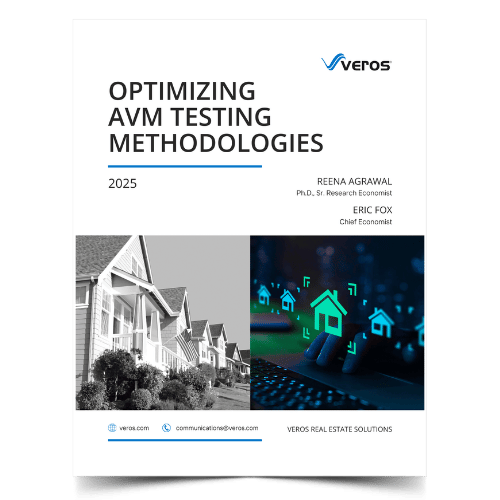As an Automated Valuation Model (AVM) provider for residential property valuation, Veros Real Estate Solutions (Veros®) would like to thank Brookings for its report, “Governing the Ascendancy of Automated Valuation Models,” published in October 2023, and its contribution to the ongoing discourse in the field of AVMs and their societal impacts. The report provides valuable observations on the design and use of AVMs and policy recommendations governing their use.
While Veros acknowledges the insights provided in the research and the continued dialogue around these proven tools, several aspects of the report are incorrect or unsupported. For example, Veros would like to address certain aspects of the report pertaining to racial bias and the perpetuation of effects of historical redlining by AVMs.
Veros believes the following points are worth taking a closer look at:
- Brookings’ assertion: AVMs are themselves not without bias [pp. 8].
Veros’ response: Brookings’ assertion on AVM bias is entirely based on the findings of twin reports from the Urban Institute, and these are generalized to encompass the entire set of AVMs in the market. Veros conducted and published research on AVM bias in 2022 (“AVM Performance Report: Is There Evidence of Racial Bias?”), and analyzed overvaluations (P15H and P10H), undervaluations (P15L and P10L), and errors (median absolute errors) with respect to racial compositions of neighborhoods in five metros (Chicago, Atlanta, Houston, Los Angeles, and Philadelphia). Veros’ research found no evidence of racial bias in our AVM estimates provided by VeroVALUESM. Further, the VeroVALUE AVM does not include any protected class variables or their proxies (demographic and social characteristics of any party involved in real estate transactions) in its models. Veros does recommend that other AVM providers conduct similar testing to validate whether their AVM is impacted by racial bias or not. To say all AVMs are themselves not without bias is a circular argument. This is because any determination of home values using an AVM requires data and any assessment of bias would rely on the same datasets.
2. Brookings’ assertion: AVMs may perpetuate the effects of historical redlining. This is inherent to the design of current AVMs, because they predict the sales price of a home, learning from past sales prices and using geography as an input [pp. 10].
Veros’ response: Veros would like to point out that geography, that is, boundaries drawn in redlining maps, are not used as input in our VeroVALUE AVM models. Veros’ research published in 2023 (“Does Historical Redlining Influence Today’s AVM Estimates”) on AVM estimates of homes located in redlined versus non-redlined neighborhoods of Los Angeles found no evidence that redlining boundaries had any impact on VeroVALUE AVM home valuations after controlling for physical attributes of homes and other external factors. An update featuring several other metros will be released in the first quarter of 2024. This update will validate the conclusions drawn from our Los Angeles study on a broader scale.
- Brookings’ policy recommendation #7: Employing new forms of AVMs to counter historical redlining [pp.19].
Veros’ response: The Brookings report recommends alternative models that would display a “normalized estimate of the value of a property based on its characteristics, but independent of its location and geographic features.” Veros’ research mentioned in point two above analyzed AVM estimates in two spatially distant neighborhoods within a single historically redlined area in Los Angeles. These neighborhoods differed because one was near a certain geographical feature (lake) while the other was near man-made features (highways). Veros’ study found that home estimates were higher for properties located near the geographical feature (lake) after controlling for the physical characteristics of properties. Hence, Veros believes that geographic features influence property values.
To conclude, Veros would like to thank Brookings for continuing the discussion on the common goal of accuracy and fairness in AVMs. Veros suggests that Brookings consider reviewing the two referenced studies as a potential foundation for collaboration. Brookings’ insights and perspectives are valuable, and Veros believes that a collaborative examination of these studies could contribute significantly to our shared understanding of the subject.







